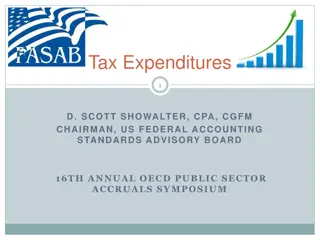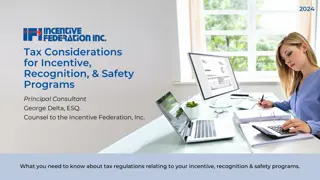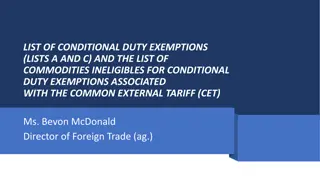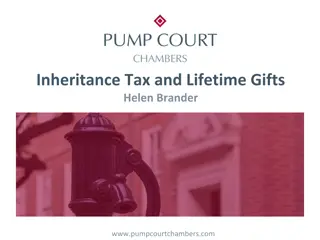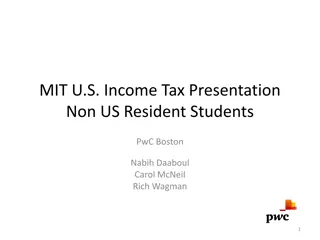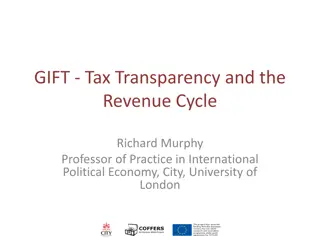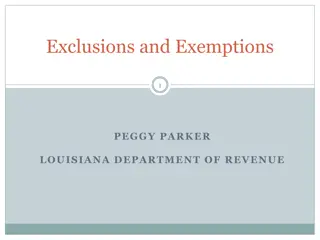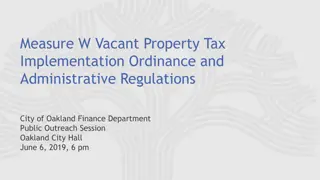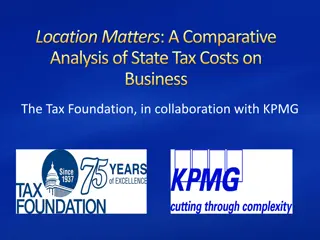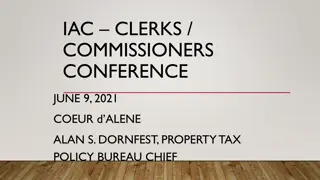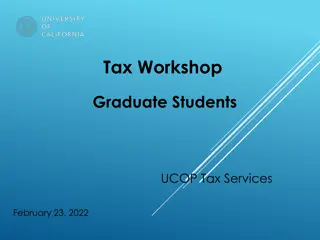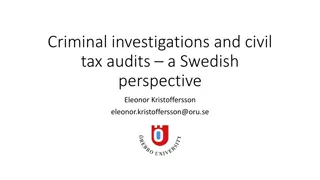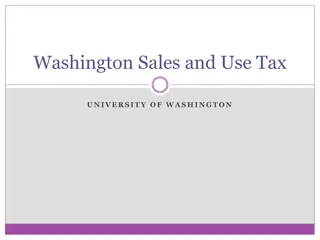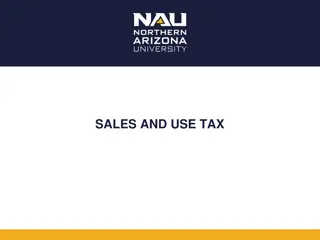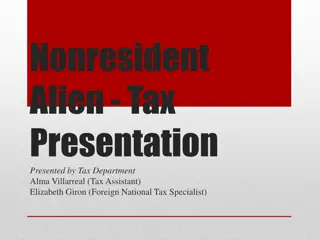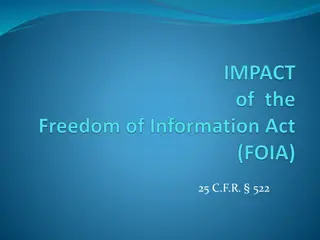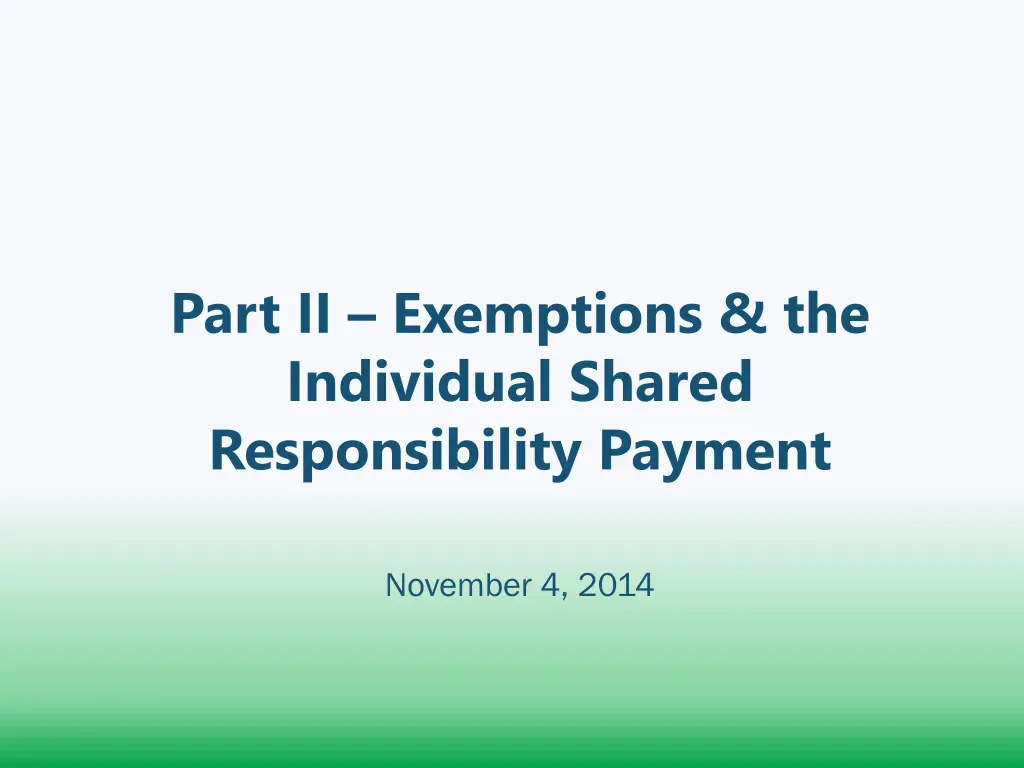
Understanding Exemptions for Individual Shared Responsibility Payments
Learn about exemptions for the Individual Shared Responsibility Payment under the Affordable Care Act, including requirements for health insurance coverage, eligibility for exemptions, and the calculation of the Individual Responsibility Payment. Explore the different types of exemptions, such as minimum essential coverage and who needs to apply for an exemption.
Download Presentation

Please find below an Image/Link to download the presentation.
The content on the website is provided AS IS for your information and personal use only. It may not be sold, licensed, or shared on other websites without obtaining consent from the author. If you encounter any issues during the download, it is possible that the publisher has removed the file from their server.
You are allowed to download the files provided on this website for personal or commercial use, subject to the condition that they are used lawfully. All files are the property of their respective owners.
The content on the website is provided AS IS for your information and personal use only. It may not be sold, licensed, or shared on other websites without obtaining consent from the author.
E N D
Presentation Transcript
Part II Exemptions & the Individual Shared Responsibility Payment November 4, 2014
2 Steps in the Tax Return Related to the ACA There is a requirement to have health insurance coverage starting Jan. 1, 2014. People without coverage may pay a shared responsibility payment. Did everyone on the tax return have coverage all year? YES Step 1 NO Go to Step 2. Is anyone on the tax return eligible for an exemption from the coverage requirement for any month during the year? Step 2 Can this exemption be granted by the IRS on the tax return? OR Does this exemption require approval from the Marketplace? If no coverage and no exemption, calculate Individual Responsibility Payment using tax worksheet. Step 3 If someone on the tax return purchased coverage in the Marketplace and qualifies for a premium tax credit, complete Form 8962. Step 4
4 What is minimum essential coverage (MEC)? QUALIFIES AS MEC LIMITED BENEFITS THAT ARE NOT MEC Employer sponsored coverage Employee coverage COBRA Retiree coverage Single-benefit coverage (e.g., dental-only or vision-only plans) Accident or disability insurance Workers compensation AmeriCorps/AfterCorps coverage Limited-benefit Medicaid Family planning services Tuberculous treatment Pregnancy-related Emergency medical condition 1115 demonstrations Medically needy Limited-benefit TRICARE Space-available care Line-of-duty care Individual health insurance Purchased from a health insurance company Purchased through the Marketplace Provided through a student health plan Government-sponsored plans Medicare Most Medicaid CHIP Most TRICARE Most VA State high-risk insurance pools Peace Corps Refugee Medical Assistance Exemption available for 2014 no penalty
5 Who needs an exemption? Most people Most people have minimum essential coverage (MEC) have minimum essential coverage (MEC) all year The vast majority tax filers will be able to check the box on Line 61 all year Each individual on the tax return who did not have MEC for the entire year should be Each individual on the tax return who did not have MEC for the entire year should be screened for exemption eligibility screened for exemption eligibility Start with the exemptions that can be claimed on the tax return o Much simpler than applying for Marketplace applications on paper! Some exemptions cover specific months; some are good all year Some exemptions can be claimed directly on the tax return; others need advance approval from the Marketplace Some exemptions represent transition relief to help taxpayers in 2014 only
6 Form 8965 at a Glance Form 8965 Part I Exemptions Granted by the Marketplace Types of Exemption Hardship (14+ types) Member of certain religious sects Incarceration* Membership in a Federally-recognized Indian tribe* In general, taxpayers must apply for these exemptions via paper application. People who were granted an exemption will receive an ECN (exemption certificate ECN (exemption certificate number) number), a 6 digit letter/number code, that must be entered on Form 8965. *Can also be claimed directly on the tax return!
7 Form 8965 at a Glance Form 8965 Part II Coverage Exemptions for Your Entire Household Type of Exemption Household income below filing threshold Gross income below filing threshold Expect tax software to calculate this This is the only exemption that applies to the entire household for the entire year The taxpayer does not need to file a return just to claim a coverage exemption if not otherwise required to file and income is below filing threshold
8 Form 8965 at a Glance Form 8965 Part III Coverage Exemptions for Individuals on Your Return Types of Exemption Insurance is unaffordable (>8% of income) Certain noncitizens Short coverage gap (< 3 months) Months prior to effective date of MEC that is effective on or before May 1, 2014 Incarceration Membership in a Federally-recognized Indian tribe or eligibility for services of Indian Health Service Transition relief for 2014 for certain limited benefit and non-calendar year plans People who are eligible for an exemption from the IRS will enter an exemption type (A-G).
9 Types of Exemptions Enter on Form 8965, Part I YES Does the taxpayer already have an exemption from the Marketplace? NO Does the taxpayer have income below the filing threshold? Applies to the entire household for the entire year. Enter on Form 8965, Part II YES NO Exemptions for individuals (duration varies): Exemptions for individuals that have a limited duration: Exemption IRS Code Exemption IRS Code Certain noncitizens and citizens living abroad Code C Short coverage gap Code B Health care sharing ministry Code D Federally-recognized Indian tribe or eligible for IHS Code E Coverage by May 1 or in-line Code G Limited benefit Medicaid Code H Non-calendar year coverage Code H Incarceration Code F Insurance is unaffordable Code A Aggregate cost of insurance is unaffordable Code G Individuals in a state that did not expand Medicaid Code G NO Does anyone qualify for a Marketplace hardship exemption? YES apply Enter on Form 8965, Part I NO
Exemptions for the Household Part II of Form 8965
11 Income Below Tax Filing Threshold Line 7a: Household income below filing threshold What is household income? Household income is modified adjusted gross income (MAGI) for each individual on the tax return with a tax filing requirement. o Include dependent income if dependent has a filing requirement For exemptions and individual responsibility payment: Line 7b: Gross income below filing threshold What is gross income? Gross income is all income received from all sources (unless exempt from tax) o Include the taxable portion of social security benefits and income (but not losses) on Schedules C, D or F. Do not include income of dependents with a filing requirement. Part II: Filing Threshold
12 Income Below Tax Filing Threshold Who should claim this exemption? A taxpayer that does not have a filing requirement and does not filegets the exemption automatically for everyone properly claimed on the tax return There is no need to file only to report health coverage or claim the exemption A taxpayer that does not have a filing requirement but chooses to fileanyway should file a Form 8965 if one or more people on the tax return are uninsured A taxpayer that has a tax filing requirement should report coverage and check for exemption eligibility in Parts I or III of Form 8965 A dependent with a filing requirement doesn t need to report coverage, exemptions or individual responsibility payment Part II: Filing Threshold
Exemptions for Individuals Part III of Form 8965
14 Part III Exemptions for Individuals Claimed on the Return A-H Mark applicable months Sonia Reyes B X X 111-22-3333 Part III: Exemptions Granted on Return
15 Individuals in a State that Did Not Expand Medicaid (Code G) New! as of 11/21/14 This exemption applies to: Individuals who resided at any time during the year in a state that did not expand Medicaid, and Had income below 138% FPL (i.e., would have been eligible for Medicaid if the state had expanded). Available on the return in 2014 only. In future years, must apply for (and be denied) Medicaid to claim this exemption! Example Rashid was uninsured for all of 2014. His wife, Miriam, had insurance all year through work. Leila was born in November, was covered by Medicaid. Their household income was $25,000 (128% FPL for a family of 3) and they live in Texas, a non-expansion state. They are all U.S. citizens. Does Rashid qualify for an exemption? Does Rashid qualify for an exemption? Yes, Rashid s household income is below 138% FPL and he lived in a non-expansion state. Rashid qualifies for this exemption for the entire year even if he had other insurance options, such as coverage through his wife s employer or insurance in the Marketplace with PTC.
16 U.S. Citizens Living Abroad and Certain Noncitizens (Code C) This exemption applies to: Individuals who are not U.S. citizens, U.S. nationals or lawfully present (i.e., undocumented immigrants) 1040NR (or 1040NR-EZ) filers Individuals who are residents of U.S. territories U.S. citizens or residents who are absent from the U.S. for at least 330 full days within a 12-month period U.S. citizens who are bona fide residents of another country for the entire tax year. Example Fatima has an ITIN and files taxes but she is not lawfully present in the U.S. Her husband and daughter are U.S. citizens Fatima Diallo C X 999-11-1111 Part III: Exemptions Granted on Return
17 Short Coverage Gap (Code B) Short coverage gap (< 3 months) If the coverage gap is 3 months or longer, none of the months in the gap qualify for exemption. If there are multiple gaps in a year, only the first gap qualifies. Example John doesn t have insurance in January, February or March. He gets a new job in March and his insurance starts April 1. April 1 John is uninsured. Coverage Begins APR JAN MAR John does not qualify for the exemption for a short coverage gap because the gap is not less than three full calendar months. Part III: Exemptions Granted on Return
18 Coverage Gap Prior to Obtaining MEC (Code G) Coverage gap prior to obtaining MEC that is effective by May 1, 2014 For a person who enrolls in Marketplace coverage, Medicaid or CHIP, or other individual or group insurance with an effective date on or before May 1, 2014, or For people who were in line for Marketplace coverage at the end of open enrollment, even if their coverage effective date was after May 1. Example John doesn t have insurance in January, February or March. He gets a new job in March and his insurance starts April 1. April 1 John is uninsured. Coverage Begins APR JAN MAR John qualifies for an exemption for months prior to the effective date of MEC that is effective on or before May 1. Part III: Exemptions Granted on Return
19 Non-Calendar Year Employer-Sponsored Plan (Code H) Exemption is available if: The person was eligible for, but did not enroll in, coverage offered by an employer, and The coverage began in 2013 and ended in 2014 Available for 2014 only Example John s employer offers health coverage with a plan year of July 1 June 30. John is offered coverage starting July 1, 2013 and turns it down. He is uninsured. John is eligible for this exemption (Code H) for January June 2014. Part III: Exemptions Granted on Return
20 Exemption for Particular Individuals Exemption for incarcerated individuals (Code F or Marketplace exemption) Can be claimed for any months someone on the tax return was incarcerated for at least one day in the month What is incarceration? Confinement in a jail, prison or similar penal institution or correctional facility Does not include time in jail pending disposition of charges (being held but not convicted of a crime) Does not include time in probation, parole, or home confinement Reminder: Reminder: Some exemptions can be claimed either from the Marketplace or on the tax return. If someone already has a Marketplace exemption in hand, use it on Form 8965. If not, claim the exemption directly on the tax return rather than attempting to get the same exemption through the Marketplace. Part III: Exemptions Granted on Return
21 Exemption for Particular Individuals Exemptions based on religion Members of a health care sharing ministry (Code D exemption) Members of certain religious sects (Marketplace exemption) Code D or Marketplace Exemptions based on Indian tribe affiliation Members of a Federally-recognized Indian tribe (Code E Marketplace exemption) An American Indian, Alaska Native, spouse or dependent of either who is eligible for services through the Indian Health Services (Code E E or Marketplace exemption) Code E or Code Part III: Exemptions Granted on Return
22 Limited Benefit Medicaid and TRICARE (Code H) Some government coverage options are not MEC because they offer limited benefits Exemptions are available for: Family planning services Medicaid Pregnancy-related services Medicaid Tuberculosis-related services Medicaid Emergency medical condition Medicaid Section 1115 Medicaid (limited-benefit coverage provided in some states to people who were not eligible for comprehensive Medicaid) Medicaid for the medically needy (requires beneficiaries to spend down income into Medicaid range by paying for medical expenses) Limited-benefit TRICARE coverage for space-available care Limited-benefit TRICARE coverage for line-of-duty care Part III: Exemptions Granted on Return
23 Coverage is Unaffordable (Code A) In many cases, this is the most complex exemption to claim Because of this, consider using this exemption only when no other exemption applies. For insurance to be unaffordable, the cost of coverage must exceed 8 percent of household income. Household income: The key is understanding which plan cost to measure against household income Part III: Exemptions Granted on Return
24 Coverage is Unaffordable (Code A) Which plan cost should be compared to household income? Is the taxpayer or family member eligible for coverage through an employer? Does the taxpayer or family member have no offer of employer-sponsored coverage? As an employee? If yes, does the lowest-cost bronze Marketplace plan for all uninsured, nonexempt members of the tax household cost more than 8% of household income? Find the lowest cost bronze plan at the Marketplace Account for any PTCs the person would have been eligible to receive If yes, does the lowest-cost self-only plan cost more than 8% of household income? Enter Code A for each applicable month As a member of the employee s family? If yes, does the lowest-cost plan that covers everyone on the return who is eligible for coverage and is not otherwise exempt cost more than 8% of household income? Enter Code A for each applicable month Do two or more family members have offers of employer coverage? (1) Individual coverage offers are affordable but (2) their combined cost is greater than 8% of income and (3) no family coverage is offered for less than 8% of income? Enter Code G for the entire year Part III: Exemptions Granted on Return
25 Coverage is Unaffordable (Code A) Which plan cost should be compared to household income? What information does the taxpayer need? For employer offer:The employee premium for the lowest cost employee or family plan (as applicable) offered during the 2014 plan year(s) For no employer offer: The lowest cost bronze plan in the Marketplace after subtracting the amount of PTCs a person would be eligible to receive The problem: This information may be hard to obtain Part III: Exemptions Granted on Return
26 Example: Affordability Exemption Sonia Reyes is offered health insurance at work but she doesn t accept it. Household Income: $47,000 Sonia s premium for employee-only plan: $196/month ($2,350/year) 5% of income Sonia s premium for employee plus children: $392/month ($4,700/year) 10% of income No spousal coverage is offered Do Sonia or her family qualify for exemptions based on affordability? Part III: Exemptions Granted on Return
27 Example: Affordability Exemption Test for Sonia (an employee with an offer of ESI) Household Income: $47,000 Sonia s premium for employee-only plan: $2,350/year (5% of income) Sonia s premium for employee plus children: $4,700/year (10% of income) No spousal coverage is offered Does the lowest-cost plan that covers only the employee cost more than 8% of household income? No, the lowest cost employee-only plan is 5% of income. The plan is considered affordable. Sonia does not qualify for exemption on the basis of affordability. Part III: Exemptions Granted on Return
28 Example: Affordability Exemption Test for the kids (family members with an offer of ESI) Household Income: $47,000 Sonia s premium for employee-only plan: $2,350/year (5% of income) Sonia s premium for employee plus children: $4,700/year (10% of income) No spousal coverage is offered Does the lowest-cost plan that covers the kids cost more than 8% of household income? Yes, the kids are eligible for an exemption because the cost of coverage is greater than 8% of household income. On Form 8965, the kids will be listed in Part III and Code A will be entered for each month. What about Medicaid or CHIP? The children may be eligible for Medicaid or CHIP, but eligibility for those programs is not taken into account in awarding this exemption. Part III: Exemptions Granted on Return
29 Example: Affordability Exemption Test for Gilberto (a person without an offer of ESI) Household Income: $47,000 Sonia s premium for employee-only plan: $2,350/year (5% of income) Sonia s premium for employee plus children: $4,700/year (10% of income) No spousal coverage is offered Does the lowest-cost bronze plan covering only Gilberto in the Marketplace, after accounting for premium tax credits, cost more than 8% of household income? His lowest cost bronze plan is $2,000 (4% of household income), taking into account premium tax credits. The plan is considered affordable. He is not eligible for this exemption. Part III: Exemptions Granted on Return
Exemption: Aggregate Cost of Coverage 30 Bob and Joan have jobs that offer health coverage to the employee only. Household Income: $45,000 Premium cost for Bob: $2,400/year 5.3% of income Premium cost for Joan: $2,100/year 4.6% of income Aggregate cost: $4,500/year 10% of income Neither is offered family coverage that would cover them both for less than 8% of income 12% 10% They can claim the Code G exemption because the total cost of coverage exceeds 8% of income. 8% 6% 10% 4% 5.3% 4.6% 2% 0% 1 2 3 Part III: Exemptions Granted on Return
32 Why apply for an exemption through the Marketplace? A list of exemptions are available from the Marketplace but most are either: Duplicative of exemptions that can be claimed directly on the tax return, or Aren t available retrospectively At the time of tax filing in 2015, three types of exemptions will be available through the Marketplace: 1. Religious conscience - Members of religious sects that object to insurance coverage, including Medicare and Social Security (e.g., Mennonite, Amish) 2. Membership in an Indian Tribe (also available on the tax return) 3. Hardship - Many categories of hardship Part I: Exemptions from the Marketplace
33 Marketplace Exemptions: Hardship Hardship Exemptions Granted by Marketplace Duration Financial or domestic circumstances 1. Homelessness 2. Eviction in the last 6 months or facing eviction or foreclosure 3. Utility shut-off notice 4. Domestic violence 5. Recent death of a close family member 6. Disaster that resulted in significant property damage 7. Bankruptcy in the last 6 months 8. Debt from medical expenses in the last 24 months 9. High expenses caring for ill, disabled or aging relative 10. Failure of another party to comply with a medical support order for a dependent child who is determined ineligible for Medicaid or CHIP 11. Through an appeals process, determined eligible for a Marketplace QHP, PTC, or CSR but was not enrolled 12. Determined ineligible for Medicaid because the state did not expand 13. Individual health insurance plan was cancelled and you believe Marketplace plans are considered unaffordable 14. Other hardship in obtaining coverage (including for people in AmeriCorps, VISTA and NCCC who are enrolled limited duration or self- funded coverage) At least one month before and after hardship When to Apply Up to 3 years after the month of the hardship (but documentation is required in most circumstances so earlier is better) Part I: Exemptions from the Marketplace
34 Marketplace Exemptions: Hardship #12 Update 11/21/14 Update 11/21/14 A taxpayer can still apply for this exemption through the Marketplace (below) but it can also be claimed directly on the tax return as a Code G Code G hardship by a person who lived in a non-expansion state and had household income below 138% FPL. People who meet these criteria can claim the exemption on their tax returns even if they did not apply for Medicaid and receive a denial in 2014. Ineligible for Medicaid based on state decision not to expand Available to low-income adults (<138% FPL) To receive this exemption from the Marketplace, the taxpayer must: o Have applied for Medicaid before December 31, 2014, and o Be denied Medicaid because the state did not expand coverage Problem Problem: : Few people understood that a denial was required in order to get the exemption from the Marketplace For those who did apply for and were denied Medicaid: o Many will receive an automatic exemption without applying for the exemption at the Marketplace o A person will not get an automatic exemption if he or she: Applied directly at the state Medicaid agency instead of the Marketplace Applied at the Marketplace but had income above the poverty line Part I: Exemptions from the Marketplace
35 Applying for a Hardship Exemption Consider a Marketplace exemption if a member of the household is: - Uninsured for one or more months, and - Not eligible for an exemption that is claimed directly on the tax return. A Marketplace exemption application must be printed, completed and mailed Processing takes 2+ weeks (may be significantly longer) Should I Make a Referral to Complete a Hardship Application? A referral to a health care assister is one option but it causes additional delay Consider helping the client complete the hardship application at your tax site No special health care knowledge is needed. Application requires: Name and contact info Dependents Documentation of exemption Taxpayer s signature Hardship application https://marketplace.cms.gov/applications-and-forms/hardship-exemption.pdf Part I: Exemptions from the Marketplace
36 Applying for a Hardship Exemption Most hardship exemptions require documentation of the hardship. - E.g., Hardship of utility shut-off requires a copy of the shut-off notice Note: The exemptions claimed on the tax return apply to both the FFM and state-run marketplaces. For exemptions that must be approved by the Marketplace, the FFM is processing exemptions for all states except Connecticut. Part I: Exemptions from the Marketplace
37 Types of Exemptions Enter on Form 8965, Part I YES Does the taxpayer already have an exemption from the Marketplace? NO Does the taxpayer have income below the filing threshold? Applies to the entire household for the entire year. Enter on Form 8965, Part II YES NO Exemptions for individuals (duration varies): Exemptions for individuals that have a limited duration: Exemption IRS Code Exemption IRS Code Certain noncitizens and citizens living abroad Code C Short coverage gap Code B Health care sharing ministry Code D Federally-recognized Indian tribe or eligible for IHS Code E Coverage by May 1 or in-line Code G Limited benefit Medicaid Code H Non-calendar year coverage Code H Incarceration Code F Insurance is unaffordable Code A Aggregate cost of insurance is unaffordable Code G Individuals in a state that did not expand Medicaid Code G NO Does anyone qualify for a Marketplace hardship exemption? YES apply Enter on Form 8965, Part I NO
38 Individual Shared Responsibility Payment (ISRP) aka Individual Responsibility Payment aka Penalty
39 Individual Shared Responsibility Payment (ISRP) Year Full-year payment is greater of: 2014 1% of income above tax filing threshold (up to cap*) $95 per adult, $47.50 per child (up to cap of $285) 2015 2% of income above tax filing threshold (up to cap*) $325 per adult, $162.50 per child (up to cap of $975) 2016 2.5% of income above tax filing threshold (up to cap*) $695 per adult, $347.50 per child (up to cap of $2,085) > 2016 Values increased by a cost-of-living adjustment * Capped at national average premium of a bronze level plan purchased through a Marketplace. For 2014, the cap is $2,448 per individual ($204 per month per individual), with a maximum of $12,240 for a family with five or more members ($1,020 per month for a family with five or more members). REMINDER
40 Calculating the ISRP Partial Year Coverage The ISRP is prorated for the number of months without coverage during the tax filing year Uninsured and not eligible for exemption Gets a job with employer coverage Jan Feb Mar Apr May Jun Jul Aug Sep Oct Nov Dec Without coverage for 7 months ISRP = 7/12 of annual calculation
41 Example: John (Single) Income: $17,000 (148% FPL) Filing Status: Single Adults: 1 Children: 0 Tax Filing Threshold: $10,150 Months Uninsured: 12 Penalty Calculation: 1. $17,000 - $10,150 = 2. $95 x 1 adult = $6,850 x 1% $68.50 ISRP for 2014 $95.00
42 Calculating the ISRP - Single $600 $500 $400 $300 $200 $100 no penalty $0
43 Calculating the ISRP - Married Filing Jointly with 1 child $600 $500 $400 $300 $200 $100 no penalty $0
44 Example: Reyes Family (Married Filing Jointly) Income: $39,500 (168% FPL) Filing Status: Married, filing jointly Adults: 2 (both uninsured) Children: 2 (both uninsured) Tax Filing Threshold: $20,300 Months Uninsured: 12 ISRP Calculation: 1. $39,500 - $20,300 = 2. $95 x 2 adults + $47.50 x 2 children = $19,200 x 1% $192.00 ISRP for 2014 $285.00
45 Example: Reyes Family (Married Filing Jointly) Income: $39,500 (168% FPL) Filing Status: Married, filing jointly Adults: 2 (one insured) Children: 2 (both insured) Tax Filing Threshold: $20,300 Months Uninsured: 12 ISRP Calculation: 1. $39,500 - $20,300 = 2. $95 x 1 adults = $19,200 x 1% $192.00 ISRP for 2014 $95.00
46 Resources Exemptions IRS Coverage Exemption Table (with descriptions) http://www.irs.gov/uac/ACA-Individual-Shared-Responsibility-Provision-Exemptions Draft Form 8965 http://www.irs.gov/pub/irs-dft/f8965--dft.pdf Draft Instructions for Form 8965 http://www.irs.gov/pub/irs-dft/i8965--dft.pdf Marketplace exemption information and applications https://www.healthcare.gov/fees-exemptions/fees-exemptions-overview/ Shared Responsibility IRS Affordable Care Act Resources www.irs.gov/aca IRS Shared Responsibility Resources http://www.irs.gov/uac/Individual-Shared-Responsibility-Provision

